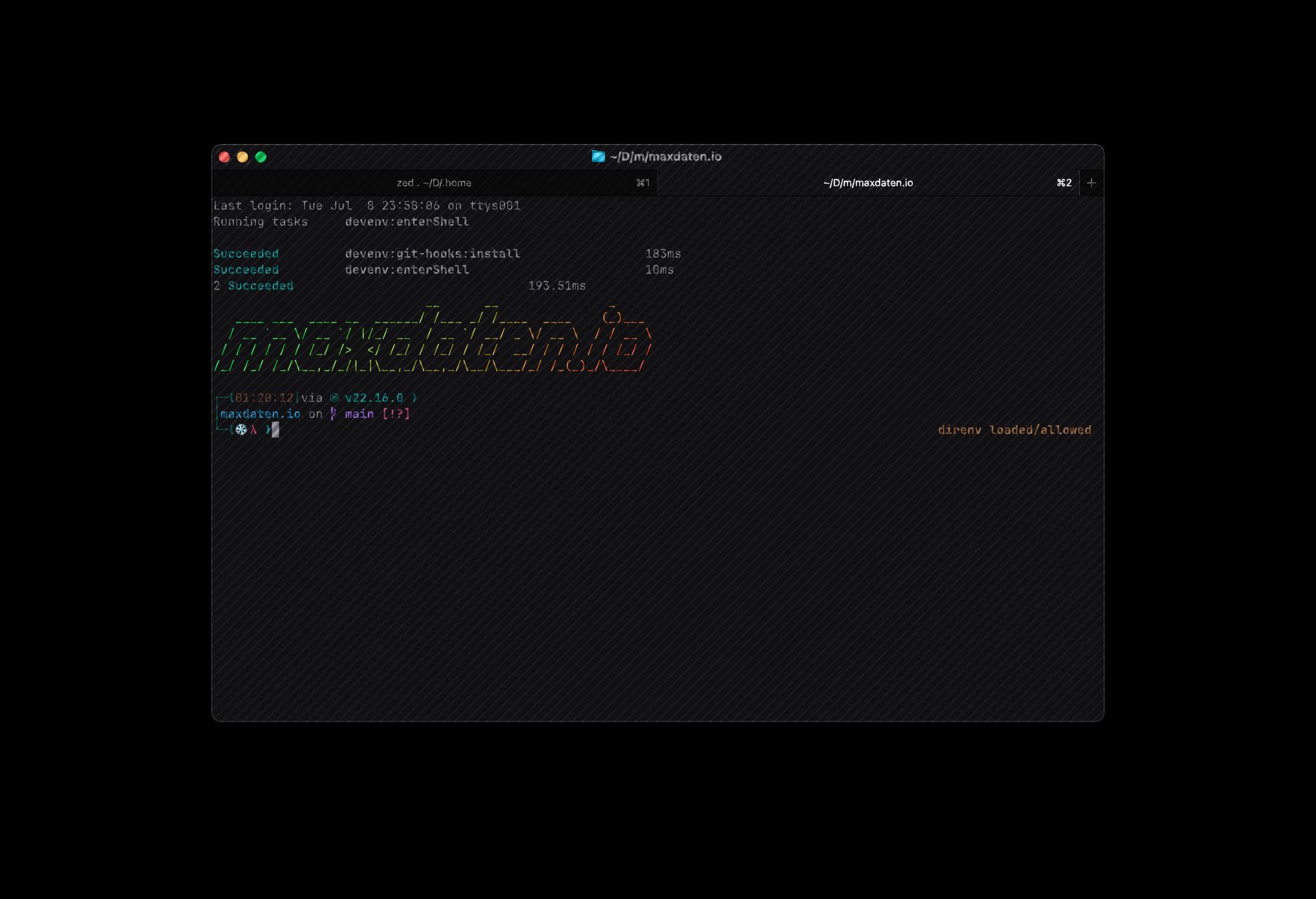My 2025 Developer Tech Stack: Tools for DevOps & Productivity

In this post, I provide a comprehensive overview of the software development tools and technologies that form my core DevOps toolkit. This is the tech stack for a software consultant that I rely on daily, refined over years of building complex systems. You’ll find everything from my development environment and infrastructure choices to the hardware and productivity apps that keep me efficient.
Core Software Development Environment
Editor & Terminal
- Zed - Code editor for its speed, ai assistance and collaborative features
- JetBrains IDEs - IntelliJ IDEA, WebStorm, and other language-specific IDEs for complex projects
- Ghostty - Fast, feature-rich terminal emulator
- Fish - Smart and user-friendly command line shell with excellent autocompletion
Project Environment Management
- Nix - Reproducible package management and system configuration
- devenv - Developer environments with Nix for per-project reproducible setups, topic for an upcomming post about how I setup project workspaces with devenv
- direnv - Automatically loads and unloads environment variables based on directory
Languages & Runtimes
- Haskell - Primary functional programming language, especially for complex business logic
- Kotlin - Modern JVM language for Android development and backend services, strong eDSL capabilities, providing quiz-buzz backend
- Svelte & SvelteKit - Fueling this blog and quiz-buzz web frontend
- TypeScript - For full-stack web development and tooling
- Python - Automation, data processing, and rapid prototyping
- Scala - Functional programming on the JVM for data processing and distributed systems
- Java - Enterprise applications and Spring-based microservices
My Go-To Infrastructure & DevOps Toolkit

Cloud Platforms
- Google Cloud Platform - Primary cloud provider for most client projects
- Google Kubernetes Engine (GKE) - Managed Kubernetes for container orchestration
- Google Cloud Storage - Object storage and backup solutions
Infrastructure as Code
- NixOS - Declarative system configuration and reproducible deployments
- Terraform - Multi-cloud infrastructure provisioning
- Helm - Kubernetes package management
- Kustomize - Kubernetes configuration management
CI/CD & Automation
- GitHub Actions - Primary CI/CD platform
- Flux CD - GitOps toolkit for Kubernetes deployments and continuous delivery
Monitoring & Observability
- Prometheus - Metrics collection and alerting, Google Cloud Managed Service for Prometheus for my own cluster
- Grafana - Visualization and dashboards
- OpenTracing - Vendor-neutral distributed tracing standard and instrumentation
Security & Secrets Management
- SOPS - Secrets encryption with KMS integration
- cert-manager - Automated TLS certificate management
Development Tools
Version Control & Collaboration
- Git - Preferable with trunk-based development supported by a strong CI
- GitHub - Primary code hosting and collaboration platform
- Conventional Commits - Standardized commit message format
Local Development
- Docker - Containerization for development and testing
- Docker Compose - Multi-container application orchestration
- Telepresence - Local development against remote Kubernetes clusters
API Development & Testing
- Postman - API development and testing
- curl - Command-line HTTP client
- HTTPie - User-friendly HTTP client
- OpenAPI - API specification and documentation
My Hardware Setup for Development and Local AI
Computing
- MacBook Pro 16” (Apple M4 Max, 128 GB) - Primary development machine
- 2 External 4K Monitor - Extended workspace for productivity
- GeForce RTX 5090, Ryzen 7 9800X3D, 64GB RAM - Dual Boot Machine for local AI Development
Accessories
- AirPods Pro Gen 2 - Focus during deep work sessions and online calls
Productivity Setup & Communication
Organization
- Notion - Collecting project ideas, organizing my reading list
- Calendly - Client consultation meeting scheduling
- SideNotes - Quick note-taking and task management in the sidebar
- Raycast - Quick querying local ollama models, looking up nix packages, hyperkey shortcuts for quick launching tools, etc.
Communication
- Slack - Team communication and client coordination
- Zoom - Video conferencing for client meetings
- Discord - Private and professional communication, channel management and engagement
Learning & Resources
Documentation & Reference
- Kubernetes Documentation - Official K8s reference
- Google Cloud Documentation - GCP service references
- NixOS Manual - System configuration guidance
- Noogle - Finding functions and implementations in nix
Continuous Learning
- Hacker News - Tech industry news and discussions
- Reddit r/devops - Community insights and best practices
- CNCF Landscape - Cloud-native technology ecosystem overview
This entire developer tech stack is constantly evolving, but it currently provides the power and flexibility needed to tackle modern software and infrastructure challenges. I hope this look into my DevOps toolkit gives you some new ideas for your own workflow.
